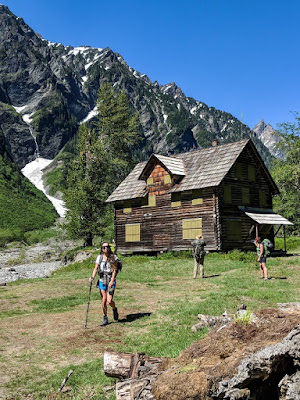According to the American Hiking Society, there are 10 essential items that you should pack on every single hike whether you plan a short day hike for a couple of hours or you plan on trekking through the backcountry for a couple of months. You should pack the following items and know how to use them.
1) Navigation – Map and Compass: GPS and a smart phone are very handy devices, although they require batteries and a signal and do not always work in the backcountry. You should always carry a paper map and a compass and be sure that you know how to correctly use them. Consider an altimeter and know how to read a topographic map on complex mountain hikes.
2) Appropriate footwear: well-fitting hiking boots or shoes are a must; happy feet make for happy hiking. Look for support, protection and traction when selecting footwear. Always pack extra socks and consider a change of clothes beyond what you think you would normally need, depending on your packing weight restrictions.
3) Food: pack calorie dense foods that do not require cooking like nuts, jerky, dried fruits and energy bars. You should always pack an extra day’s worth of food just in case something extends your trip like bad weather or an injury.
4) Water: most people require about a half a liter of water every hour during moderate activity and temperatures. Start off with at least a water bottle and know where you will fill your bottle or reservoir and how to treat water while you’re on the trail, whether with chemical treatment, a purifier/filter or using a camp stove to melt snow.
5) Rain gear and dry-fast clothing: always be prepared for wet weather by wearing moisture wicking items, dressing in layers and be sure to have a synthetic jacket and a warm hat.
6) First-Aid kit: it is critical to have a first-aid kit and know how to use it. You can find pre-assembled kits and modify them to suit your needs and the number of people in your group. Every kit should include disinfecting ointment, various bandages, gauze pads, adhesive tape, over-the-counter pain medication and nitrile gloves. Anyone hitting the trail should take a first-aid and CPR class, many online courses are available through the Red Cross.
7) Safety Items including Fire: Be sure you have a way to start an emergency fire, to signal for help, to cook food or for much-needed heat. Keep some durable matches in a waterproof container along with a butane lighter and carry some form of Firestarter. If hiking in the winter and snow where firewood is not available, be sure to have a stove for a source of heat and water. In addition to fire you should always have a whistle to signal for help if needed and a light such as a headlamp with extra batteries if you need to see your map and the trail in the dark.
8) Knife or multi-tool: a knife or a multi tool is mandatory and can be used for many purposes such as repairing your gear, preparing food, making kindling or for first-aid. A multi tool includes some other convenient features like a pullout screwdriver, fold out scissors, or a can opener. If you need help or need to repair your gear in the backcountry you should also include some zip ties, duct tape, fabric repair tape and parts to repair your water filter.
9) Sun protection: protection from the sun is critically important, you should always have sunscreen, sun protective clothing and quality sunglasses. You should wear quality sunglasses regardless of cloud cover and temperature. Your sunglasses should block 100% of UV light especially if traveling on snow or ice to prevent snow blindness or cataracts from developing with long-term exposure.
10) Shelter: emergency shelter includes more than just your tent. You will need protection from the elements when hiking away from your tent especially if you are injured or stranded. Carry a lightweight blanket or a bivy sack when leaving your campsite.
These items, along with following the basic principles of Leave no Trace and carrying a trash bag with you to clean up your mess, will get you through your hike safely and prepared. Make the most of your hike with quality gear from Cascade Mountain Tech, such as our wide selection of hiking trekking poles, lightweight packable camp chairs, camp bedding and more.
Cascade Mountain Tech offers high-quality camping and hiking gear to make the most of your next adventure. We believe that outdoor adventure should be accessible to everyone. Contact us to check out our wide selection of quality gear to get prepared for your next hike.






